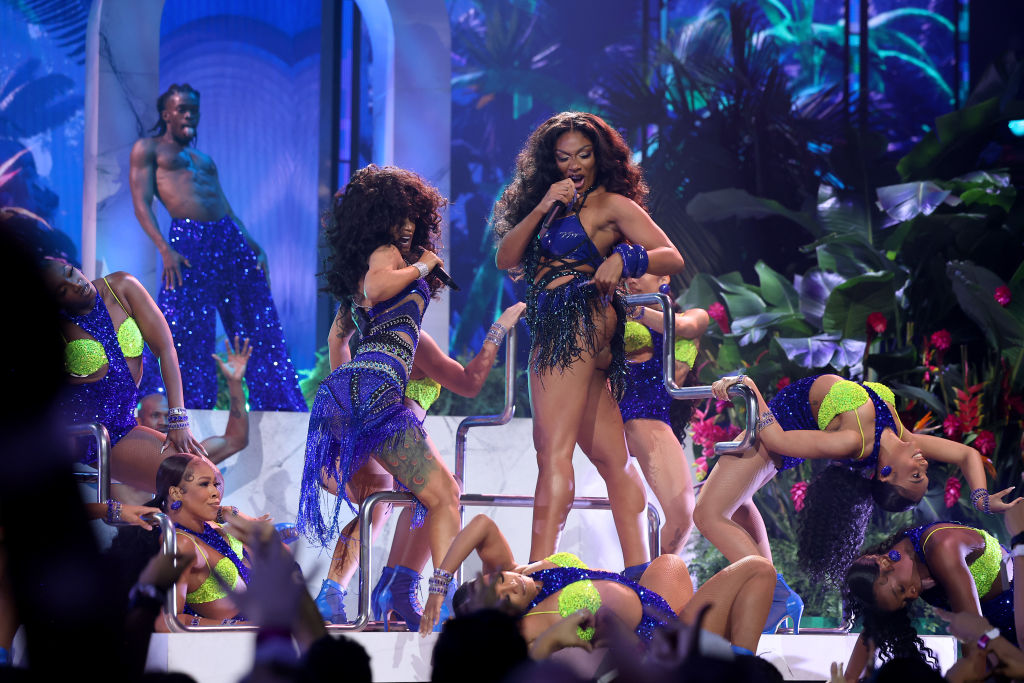While TV viewers watched Tuesday’s VMAs enthusiastically honor the 50th anniversary of hip-hop, the reaction of the crowd inside the venue told a different story.
Tuesday evening’s MTV Video Music Awards evoked the sage lyrics of A Tribe Called Quest’s Q-Tip on the group’s 1991 album, “The Low End Theory.” In the opener, “Excursions,” he says that “things go in cycles,” as he describes how his dad saw the connections between hip-hop and bebop.
One of the things that has kept music powerful over the years is the transference of influences and energies from one generation to the next. As several rap artists graced the VMA stage for the 2023 ceremony, it became clear that such transference had encountered a blockage. Viewers at home may have seen an eclectic show full of performances from artists that spanned eras and genres. But from inside the venue, it was evident what the crowd responded to the best.
Doja Cat performed her new single, “Paint the Town Red,” at the show. That song, released this month, is the first rap song in 2023 to reach No. 1 on the Billboard Hot 100. Ironically, in a year that celebrates a half-century of hip-hop’s emergence and dominance in culture, the audience at Newark’s Prudential Center reflected today’s music consumer, apparently detached or bored with much of hip-hop, past or present.
Lil Wayne’s opening performance of his hit “Uproar” and his new single, “Kat Food,” started strong in terms of audience enthusiasm. But the energy waned by the end of his performance, accentuated by the bombastic crowd response seconds later when Olivia Rodrigo took the stage. During Sean “Diddy” Combs’ Global Icon medley, Diddy had to do some encouraging to get the crowd into it.
The final performance of the night paid tribute to hip-hop’s 50th anniversary with a star-studded medley that included appearances from Grandmaster Flash and the Furious Five, Slick Rick and Doug E. Fresh, Nicki Minaj, Lil Wayne, LL Cool J, and DMC of Run-DMC. The tale of the tape doesn’t honestly describe how limp the attendees were during what should have been an eruptive cap on the night.
Granted, the crowd was full of Gen Z members who basked in the glory of Taylor Swift’s VMA sweep. So, the VMAs were a different audience than LL Cool J and Doug E. Fresh are accustomed to. All year, at hip-hop celebration events like DJ Cassidy’s “Pass the Mic Live” at Radio City Music Hall or LL Cool J’s “Rock The Bells” festival in Queens, the same songs played at Tuesday’s VMAs received thunderous screams and rhyme-alongs from the crowd.
In past VMAs, Diddy or Run-DMC performances usually brought the house down, even years and sometimes decades after those songs were hits. Tuesday’s VMAs illustrated that the legacy of those artists and songs is not enduring with current generations the way they used to.
Also, the sonic presentation of the songs resonates, too. Metro Boomin debuted his VMA performance on Tuesday, featuring Future, Swae Lee, A Boogie Wit da Hoodie, and NAV. Their collective performance of “Superhero” and “Calling” should have made that young crowd frenzied. Still, the crowd didn’t react the same way they did to K-pop acts Stray Kids or Tomorrow X Together, or even whenever Swift stood up to collect one of her nine trophies.
However, when Minaj, Cardi B and Megan Thee Stallion took the stage for their respective performances, the reverberation from the audience was deafening and seismic. Their response to those performances calls to mind another Q-Tip line, this time from “Check the Rhime;” “Rap is not pop/if you call it that, then stop.”

If you ask Minaj, Cardi, and Megan how they would classify “Last Time I Saw You” and “Bongos,” they most likely would answer rap or hip-hop. However, the consumer ingests these women as pop artists more and more as time goes on. It’s not hard to understand why Cardi and Megan are considered pop stars when they each have multi-platinum and diamond-certified singles, or Minaj, whose music and multi-faceted image evoke color pop imagery, particularly with her Barbie persona.
Young crowds connect more with these artists and songs than other hip-hop artists, contemporary or legendary. If the VMAs did nothing else, it further cemented the current state of music, how hip-hop’s chokehold on the pop landscape isn’t what it used to be, and the classics many of us danced to in clubs and on the radio over the years may not have the same effect they had on older generations.
MTV used to be a destination for music discovery and an aid to the longevity of artists. Today, the VMAs are one of the few moments the network entirely devotes to music performance — and that, more than anything else, could contribute to last night’s anti-climatic celebration of hip-hop.

Matthew Allen is an entertainment writer of music and culture for theGrio. He is an award-winning music journalist, TV producer and director based in Brooklyn, NY. He’s interviewed the likes of Quincy Jones, Jill Scott, Smokey Robinson and more for publications such as Ebony, Jet, The Root, Village Voice, Wax Poetics, Revive Music, Okayplayer, and Soulhead. His video work can be seen on PBS/All Arts, Brooklyn Free Speech TV and BRIC TV.
TheGrio is FREE on your TV via Apple TV, Amazon Fire, Roku and Android TV. Also, please download theGrio mobile apps today!
The post Hip-hop’s presence at MTV VMAs shows wide generational gap, disconnect with pop audiences appeared first on TheGrio.


